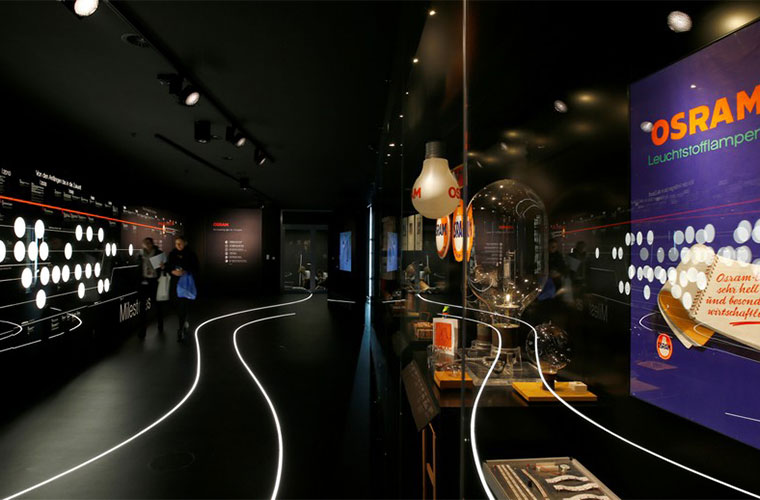‘World of light’ showroom of lamp manufacturer Osram is pictured during the official opening in Munich, Germany, October 24, 2017. REUTERS/Michaela Rehle
BERLIN/FRANKFURT (Reuters) – German lighting maker Osram expects further growth in profit and sales next year after posting 2017 results on Monday that matched expectations as it sold more automotive chips.
The Munich-based company, which competes with Philips Lighting and General Electric, plans to keep up investments and has teamed up with Continental to develop lighting products for the auto industry next year.
“The strategy is right,” the Munich-based firm said late on Monday. “Osram will continue to grow in 2018 despite negative currency effects and investments.”
Core earnings (adjusted EBITDA) at Osram rose more than six percent to 695 million euros ($807 million) on sales that rose eight percent to more than 4 billion euros, it said.
That gave it an EBITDA (earnings before interest, tax, depreciation and amortization) margin of 16.8 percent, adjusted for special items, compared with its forecast for a margin of 16.5 to 17.5 percent.
Osram said it is targeting adjusted EBITDA of around 700 million euros next year, forecasting sales to increase between 5.5 and 7.5 percent. It plans a dividend of 1.10 euros per share.
Osram had forecast comparable revenue growth of 7-9 percent for its fiscal year to end-September, diluted earnings per share of between 2.70 and 2.90 euros, and free cash flow at break-even level.
“We delivered another peak year in 2017 on the back of a strong performance whilst also making good progress on our way to becoming a high-tech company,” Chief Executive Olaf Berlien said in a statement.
Analysts had forecast fourth-quarter revenue of 1.02 billion euros on average, adjusted EBITDA of 158 million euros, adjusted EBITA of 102 million euros and net income of 34 million euros, according to a Reuters poll.
Osram makes about 45 percent of its sales from specialty lighting (SL) which is mainly traditional LED, 35 percent from opto semiconductors (OS) which is mainly automotive, and 20 percent from lighting solutions and systems (LS) for buildings and streets.
Under Berlien, Osram has undertaken an ambitious project to build a billion-euro LED chip plant in Malaysia, which will cater mainly for the general street and building lighting market when it ramps up next year.
The move was controversial with shareholders who had hoped it would focus on the highly profitable automotive niche, and caused a cooling of relations with former parent Siemens until Siemens sold its stake last month.
Osram makes about half its revenues in U.S. dollars but most of its costs are in other currencies.
Philips Lighting, which unlike Osram still has a traditional bulbs business, reported flat core profit and a 4 percent decline in quarterly sales last month.
Its LED lights, professional lighting, and home networking divisions all grew on both top and bottom lines although the United States showed some weakness on slow demand from the housing industry and small and medium-sized businesses.
GE reported a 16 percent drop in lighting revenues but a turnaround to a small profit in the third quarter, with an operating margin of 4.8 percent, partly due to a running down of its traditional lighting business and a restructuring.
Lighting is seen as one of the businesses GE could sell after vowing to dispose of billions of dollars’ worth of assets after poor quarterly results.
($1 = 0.8611 euros)
Reporting by Andreas Cremer and Georgina Prodhan, editing by David Evans and Adrian Croft
Tagged with financial, lightED, Osram
